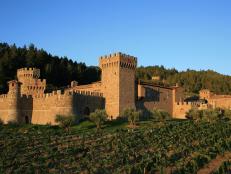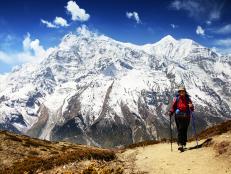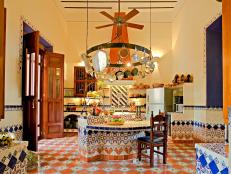10 Hidden Wine Regions Around the World
Many wine-growing regions remain under the radar because they don’t export their product, or they’re overshadowed by more established counterparts.
Cape South Coast, South Africa
South Africa's Cape South Coast doesn’t have the same international reputation as Stellenbosch and Paarl, but it’s certainly one to watch. While Swartland, just north of Cape Town, is often mentioned as an overlooked wine region, so are the lush vineyards to the south, found in Elgin and Hemel-en-Aarde (Heaven on Earth). A cooler environment than South Africa’s other wine growing areas lends itself to Elgin’s Sauvignon Blanc and pinot noir wines, with some of the best produced at Paul Cluver. Of the almost 20 wineries, make time to visit Catherine Marshall Wines, Downes Family Vineyards and Iona Wine Farm. Meanwhile, Hemel-en-Aarde excels at pinot noirs and Chardonnays and offers 15 wineries for sampling. Hamilton Russell (pictured) is the oldest, but don’t miss Creation and Ataraxia.
Cafayate, Argentina
Cafayate is found in a remote part of the Salta province, defined by red rocks and verdant vineyards ringed by imposing mountain ranges. Its high altitude and little rain make for notable Malbecs and Torrontés, a dry white wine specific to Argentina. What may be surprising is Cafayate's wine industry is just as old as the famed Mendoza region, with the gorgeous Bodega El Esteco (pictured) dating back to the 19th century. At the other end of the spectrum is the newer Piattelli Vineyards, which has become a popular spot for its sweeping views and quality wines. Finca Las Nubes is another favorite — it’s a bit further than the other wineries, but you’ll be rewarded with organic wines and an authentic experience. The wide-open Calchaqui Valleys views aren’t too bad either.
Moldova
Though it's Europe’s poorest country, the small Eastern European nation of Moldova is a mighty producer of wine. This fact is mostly unknown in the U.S. since Moldova mainly exports to Russia, Belarus and the Ukraine — and it just started exporting to the United Arab Emirates — but its reds and whites are worth seeking out. The country possesses an ancient winemaking history, and today its vineyards are centered in the regions of Valul lui Traian, Stefan Voda, Codru and Balti. Be sure to visit Purcari, an award-winning winery that’s been around since 1827. Chateau Vartely might be newer, but has quickly established a reputation for its wines. Perhaps even more famous than Moldova’s wineries are its wine cellars. Milestii Mici holds the Guinness World Record as the world’s largest collection, and the cellar is so cavernous that you need a car to explore it.
Okanagan Valley, Canada
About a four-hour drive from Vancouver, the Okanagan Valley is defined by carpeted rolling hills reminiscent of the Cotswolds. While the wine region is one of the furthest north in the world, the Okanagan enjoys less severe weather than the rest of Canada, and wines like pinot gris and Viognier do well here. Plan ahead since most wineries are only open April through September. According to Wines of British Columbia, there are 172 licensed wineries in six different regions in the Okanagan Valley, notably Kelowna and Naramata Bench. Mission Hill Winery is one of the best-known wineries — so well known, in fact, that the Duke and Duchess of Cambridge visited during their 2016 Canadian tour.
Valle de Guadalupe, Mexico
Good Mexican wine might sound like an oxymoron, but the Valle de Guadalupe region is quietly changing that perception. Less than two hours from the Tijuana border on the Baja California peninsula, you’ll find more than 100 wineries and a developing wine scene that’s exploded in the past decade. The roads are dusty and the wineries can be hard to find, but that level of authenticity is also a large part of the appeal. Well, that, and excellent wines, especially those made from Nebbiolo grapes. Las Nubes, Clos de Tres Cantos and Finca la Carrodilla are among the wineries worth visiting. Adobe Guadalupe (pictured) provides the extra benefit of luxurious lodging and horseback riding wine tours through its vineyards.
Ticino, Switzerland
Switzerland brings to mind chocolate, skiing and watches, but wine? Not so much. That’s because only about one percent is exported and not in the U.S. The Swiss and tourists are the prime beneficiaries of world-class wine, with the Lavaux region being the most famous. Tourists visiting the Ticino region, a little known Italian-speaking section near the Italian border, will find a bigger secret involving Merlot, the area’s most commonly grown grape. Pop into the Wine Museum Matasci in Tenero to learn about the area's wine history dating back to the Roman Empire, then follow the Mendrisiotto Wine Route for a good overview of Ticinese wine. Don't forget to visit Tamborini for its impressive selection.
Wairarapa Wine Region, New Zealand
Beyond the spotlight of Marlborough and its heavyweight Sauvignon Blancs, you’ll find the young Wairarapa wine region. Though small, it’s earning global attention for its pinot noirs. Martinborough is considered the center, a cute village an hour away from Wellington. Most of its 30 wineries are within walking distance of each other. Poppies Martinborough is beloved for its wine tastings (called cellar doors) and tours, as well as for its restaurant. One of the oldest, Ata Rangi, makes an acclaimed pinot noir, as does Te Kairanga (pictured). Palliser Estate, Muirlea Rise and Margrain Vineyard should also be on your radar.
Kakheti, Georgia
The Republic of Georgia is trending thanks to new flights and the under-visited capital of Tbilisi, but Georgia is also attracting attention for its wine. A small country bordered by Turkey to the west and Russia to the east, its winemaking tradition can be traced back some 8,000 years, when early attempts at wine were buried underground in clay jars, called qvevri or kvevri. This technique is still alive and well among the country’s winemakers. Base yourself in the fairytale town of Signagi (also spelled Sighnaghi) since it’s considered the epicenter of the wine region. Swirl and sip at Pheasant’s Tears, an American-owned winery that adheres to the qvevri tradition, or venture an hour out to Schuchmann Wines, which offers a hotel, wine spa and restaurant.
North Fork, New York
When it comes to wine, Long Island's North Fork tends to get overlooked in favor of the Finger Lakes upstate, a larger and somewhat older viticulture. The area also gets bypassed in favor of the Hamptons, its glitzier neighbor to the south. But that means missing out on farmland dotted with fruit stands and 36 wineries, where many are producing high-quality wines that don’t need any comparison to Napa and Sonoma. Merlot, Cabernet Franc and Sauvignon Blanc are among the wines you’ll find here. Shinn Estate makes an excellent Malbec, while Croteaux, whose tasting area resembles the south of France, is known for its rosés. You can’t beat the combination of award-winning wines and Long Island Sound views from Kontokosta Winery.
Margaret River, Australia
If you know anything about Australian wines, you’ve likely heard of Barossa Valley and McLaren Vale, both heavy producers of Shiraz. The newer wine-growing region of Margaret River, found on the Southwest coast just south of Perth, is quickly catching up on the international scene. Thanks in part to its Mediterranean climate, you’ll find more than 200 wineries producing reds and whites, especially excellent Cabernets and Chardonnays. Vasse Felix is one of Margaret River’s first wineries, and in 2017, Wine Enthusiast named it "New World Wine Maker of the Year." With more than 100 cellar doors (tasting rooms), consider visiting Leeuwin Estate, one of the area’s first and now one of the most famous. Also, visit the equally famous Voyager Estate.




